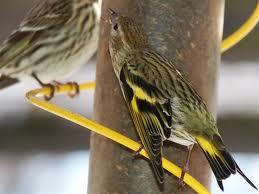The Pine Siskin Event

Pine Siskins are a small, heavily striped finch that are recognizable by their yellow edgings along the wing and tail and huge appetites. They spend almost all their lives in flocks numbering from a dozen to the hundreds. Siskins are also an irruptive species, making unpredictable migrations into areas they are not normally seen. This action is usually food driven. During this time, siskins can be found in very large numbers at your bird feeders. Unfortunately, the birds tendency to remain in large flocks is also their downfall.
Dense flocks, such as usually seen during an irruptive event, are very vulnerable to disease outbreaks especially salmonella. This highly contagious disease is transmitted through fecal matter in areas where birds congregate, such as where they nest, roost or feed. And like workers in an office building, when one gets sick, they all get sick.
Other birds, mainly ones that are found in large flocks for the majority of the year, are prone to outbreaks of salmonella. The most commonly affected are Goldfinches, House Finches and Evening Grosbeaks in our area. The salmonella bacteria attacks the respiratory system of the bird, notably the throat.
 The tissues of the throat will swell. preventing the birds from feeding. This is why most sick birds will sit at your feeders; rather than eating constantly as it appears, they are trying to get any food past their swollen throat (very similar to what happens with us when we get strep throat or mono). Birds will also be very lethargic and fluffy as they try to stay warm. They will become so docile that it is not uncommon for anyone to walk right up to the bird and not have it fly off. Most birds that get salmonella are usually dead within several days.
The tissues of the throat will swell. preventing the birds from feeding. This is why most sick birds will sit at your feeders; rather than eating constantly as it appears, they are trying to get any food past their swollen throat (very similar to what happens with us when we get strep throat or mono). Birds will also be very lethargic and fluffy as they try to stay warm. They will become so docile that it is not uncommon for anyone to walk right up to the bird and not have it fly off. Most birds that get salmonella are usually dead within several days.
Although upsetting, these die-offs often occur and is simply nature’s way of correcting an over population. The best way to prevent the spread of this or any other disease is through simple cleanliness. It is very important to keep your feeding stations clean of moldy seed, discarded shells and bird droppings. If you have sick birds, we recommend the following cleaning routine:
- Clean your feeders and trays (anywhere your birds will sit and feed) every 2 weeks with hot soapy water, more frequently if the weather turns very wet or the bird activity is high.
- Use a 10% bleach solution if you see sick birds. Be sure to rinse VERY WELL after cleaning and dry thoroughly before use. Even if you hate using bleach, it is the most effective way to kill the bacteria.
- Clean the ground below feeders of fecal matter and uneaten bird seed. You do not want to leave any area that can breed disease by your feeders.
- Move your feeding stations to another new, disease-free area.
- Feed good quality bird food to keep your birds healthy.
- If you are having a severe outbreak in your yard, take down the feeders for several days. This forces the large flocks to break up into smaller groups that will not be as prone to the disease.

